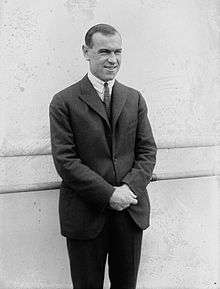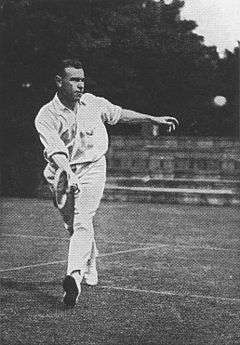Gerald Patterson
Gerald Leighton Patterson MC[3] (17 December 1895 – 13 June 1967) was an Australian tennis player.
 | |
| Country (sports) | |
|---|---|
| Born | 17 December 1895 Preston, Australia |
| Died | 13 June 1967 (aged 71) Melbourne, Australia |
| Turned pro | 1914 (amateur tour) |
| Retired | 1928 |
| Plays | Right-handed (one-handed backhand) |
| Int. Tennis HoF | 1989 (member page) |
| Singles | |
| Career record | 267–63 (80.9%)[1] |
| Career titles | 28[1] |
| Highest ranking | No. 1 (1919, A. Wallis Myers)[2] |
| Grand Slam Singles results | |
| Australian Open | W (1927) |
| French Open | 4R (1928) |
| Wimbledon | W (1919, 1922) |
| US Open | SF (1922, 1924) |
| Doubles | |
| Grand Slam Doubles results | |
| Australian Open | W (1914, 1922, 1925, 1926, 1927) |
| Wimbledon | F (1922, 1928) |
| US Open | W (1919) |
| Mixed doubles | |
| Grand Slam Mixed Doubles results | |
| Wimbledon | W (1920) |
Patterson was active in the decade following World War I. During his career he won three Grand Slam tournaments in the singles event as well as six titles in the doubles competition and one title in mixed doubles. He was born in Melbourne, educated at Scotch College and Trinity Grammar School and died in Melbourne on 13 June 1967.[4][5] He was the co-World No. 1 player for 1919 along with Bill Johnston.
History
Tall and well-built, Gerald Patterson played a strong serve-and-volley game. At Wimbledon 1919, Patterson beat 41-year-old Norman Brookes, who was defending champion (Brookes' 1914 title was the last held before World War 1) in the Challenge Round. At Wimbledon 1922, the Challenge Round was abolished and Patterson won the title (the first to be held at the current site at Church Road) beating Randolph Lycett in the final. In 1927, Patterson was five championship points down in the Australian singles final against Jack Hawkes, but won in five sets.[6]
Patterson was known as the "Human Catapult" for his powerful serve that many of the top players had trouble returning. He also enjoyed great success representing Australia in Davis Cup and amassed a 32–14 win–loss record (singles 21–10, doubles 11–4) and was part of the winning team in 1919. Patterson played Davis Cup in 1920, 1922, 1924, 1925, 1928 and finally as captain in 1946. He was a player ahead of his time, playing with a steel racquet strung with wire in 1925.
He was inducted into the Sport Australia Home of Fame in December 1986.[7] This was followed by induction into the International Tennis Hall of Fame in 1989 and the Australian Tennis Hall of Fame in August 1997.[8]
Patterson was the nephew of Australian opera singer Dame Nellie Melba and father of racing driver Bill Patterson.[4] Patterson was awarded the Military Cross for bravery as an officer in Royal Field Artillery in 1917 at Messines.
Grand Slam finals

Singles: 7 (3 titles, 4 runners-up)
| Result | Date | Championship | Surface | Opponent | Score | |
|---|---|---|---|---|---|---|
| Loss | 1914 | Australasian Championships | Grass | 4–6, 3–6, 7–5, 1–6 | [9] | |
| Win | 1919 | Wimbledon | Grass | 6–3, 7–5, 6–2 | [10] | |
| Loss | 1920 | Wimbledon | Grass | 6–2, 3–6, 2–6, 4–6 | [10] | |
| Loss | 1922 | Australasian Championships | Grass | 0–6, 6–3, 6–3, 3–6, 2–6 | [9] | |
| Win | 1922 | Wimbledon | Grass | 6–3, 6–4, 6–2 | [10] | |
| Loss | 1925 | Australasian Championships | Grass | 9–11, 6–2, 2–6, 3–6 | [9] | |
| Win | 1927 | Australian Championships | Grass | 3–6, 6–4, 3–6, 18–16, 6–3 | [9] |
Doubles: 14 (6 titles, 8 runners-up)
Mixed doubles: 1 (1 title)
| Result | Date | Championship | Surface | Partner | Opponents | Score | |
|---|---|---|---|---|---|---|---|
| Win | 1920 | Wimbledon | Grass | 7–5, 6–3 | [14] |
Grand Slam singles performance timeline
| W | F | SF | QF | #R | RR | Q# | A | NH |
Events with a challenge round: (WC) won; (CR) lost the challenge round; (FA) all comers' finalist
(OF) only for French players
| Grand Slam | 1914 | 1915 | 1916 | 1917 | 1918 | 1919 | 1920 | 1921 | 1922 | 1923 | 1924 | 1925 | 1926 | 1927 | 1928 | Titles / Played |
|---|---|---|---|---|---|---|---|---|---|---|---|---|---|---|---|---|
| Australian | F | A | not held | 3R1 | A | A | F | A | A | F | 1R | W | 1R | 1 / 7 | ||
| French | OF | not held | OF | A | A | A | 4R | 0 / 1 | ||||||||
| Wimbledon | A | not held | WC | CR | A | W | A | A | A | A | A | 4R | 2 / 4 | |||
| U.S. | A | A | A | A | A | 4R | A | A | SF | A | SF | A | A | A | A | 0 / 3 |
| 0 / 1 | 0 / 0 | 0 / 0 | 0 / 0 | 0 / 0 | 1 / 3 | 0 / 1 | 0 / 0 | 1 / 3 | 0 / 0 | 0 / 1 | 0 / 1 | 0 / 1 | 1 / 1 | 0 / 3 | 3 / 15 | |
1Patterson was the first tennis player to play in three Grand Slam singles tournaments within one calendar year.
References
- "Gerald Patterson career match record". thetennisbase.com. The Tennis Base. Retrieved 15 October 2017.
- United States Lawn Tennis Association (1972). Official Encyclopedia of Tennis (First Edition), p. 422.
- "Gerald Leighton Patterson". International Tennis Hall of Fame. Archived from the original on 30 March 2010. Retrieved 19 January 2010.
- Virginia O'Farrell. "Patterson, Gerald Leighton (1895–1967)". Australian Dictionary of Biography Online Edition.
- "The Unofficial Sister School" (PDF). The Trinity Grammarian. 28 (2): 4. July 2013.
- "Gerald Patterson". www.tennis.co.nf.
- "Hall of Fame – Gerald Patterson – Tennis". Sport Australia Hall of Fame.
- "Australian Tennis Hall of Fame". Tennis Australia.
- "Australian Open Results Archive / Men's Singles". Australian Open official website. Archived from the original on 10 September 2015. Retrieved 24 September 2015.
- "Wimbledon Rolls of Honour / Gentlemen's Singles". Wimbledon official tournament website. Retrieved 24 September 2015.
- "Australian Open Results Archive / Men's Doubles". Australian Open official website. Archived from the original on 21 September 2015. Retrieved 24 September 2015.
- "U.S. Open Past Champions / Men's Doubles". US Open official website. Archived from the original on 25 October 2007. Retrieved 24 September 2015.
- "Wimbledon Rolls of Honour / Gentlemen's Doubles". Wimbledon official tournament website. Retrieved 24 September 2015.
- "Wimbledon Rolls of Honour / Mixed Doubles". Wimbledon official tournament website. Retrieved 24 September 2015.
External links
| Wikimedia Commons has media related to Gerald Patterson. |